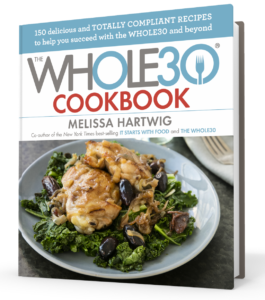Hope you had a great weekend.
This time I successfully made it through the weekend and the Whole 30. All it took was planning and determination. I successfully avoided the quiche and cinnamon rolls by eating before I prepared breakfast for everyone else and by a glass of sparkling apple cider while everyone else was munching on cinnamon rolls.
One of our readers asked to have the Whole 30 nutrition program explained in more detail so I'm providing a brief synopsis. For more information you can visit Whole30.com or purchase one of the books by Dallas and Melissa Hartwig.
The Whole 30 is a nutrition program designed to decrease systemic inflammation by removing foods from your diet, for 30 days, that are known to create inflammation. The 30 days are necessary to break old habits, build new ones, allow the body to withdrawal and heal, and break the chain of inflammation. 30 days is the minimum and the Hartwigs recommend a longer basic program if you have chronic pain, autoimmune disorders or any of the other issues they list. At the end of the 30 days, they provide guidelines for reintroducing foods into your diet in a way that will allow you to track any reactions you might have to that food/group.


The basic program is this: Remove from your diet, for at least 30 days - longer if needed, any sugar, sugar substitutes, including Stevia, sweeteners, dairy, grains, legumes, starchy vegetables, processed meats and meats or products cured or preserved with sugar. For a complete listing and explanation of Whole 30 approved and non-approved foods, please go to the website listed above and/or buy their books. This is not meant to be a full and complete description. It's an overview.
So basically, stated in the positive, the diet allows lean, preferably organic and grass fed, meats and poultry, and responsibly caught wild fish and seafood; fruits - if canned, frozen or dried, no sugars, sweeteners or preservatives; and vegetables - same as for fruit and excluding starchy vegetables. For a complete listing of Whole 30 approved foods see their website and/or buy their books.
"In My Experience..."
I have found that I feel much better and have less pain, inflammation, and swelling in my joints when I adhere to this program. It hasn't been a " cure all"; however, I've only ever gone 30 days at one time. At the end of that 30 days not only my physical energy had increased, but my mental energy and cognition had improved as well. I still had more pain and inflammation than I wanted to tolerate so I continued to research anti-inflammatory diets. I discovered several that recommended removing eggs and nuts from your diet as well. I can't tell you how distraught I was to even think about removing these two items from my diet but the pain and stiff joints helped me to make the decision. I found that I am sensitive to those to foods as well as all of the food groups the Whole 30 recommends to stay away from.Stop by Friday's post for and I'll share some of my favorite recipes from the Whole 30 Cookbook!
More questions? Drop them in a comment and I'll answer them throughout the week.
Are you thinking about starting a nutrition program? Let us know. We'll be one of your cheerleaders.
Do you have, or would you like more, information on anti-inflammatory diets: Share in the comments.
Hope you have a great day.
To your Health!
Deanna and Ray
No comments:
Post a Comment